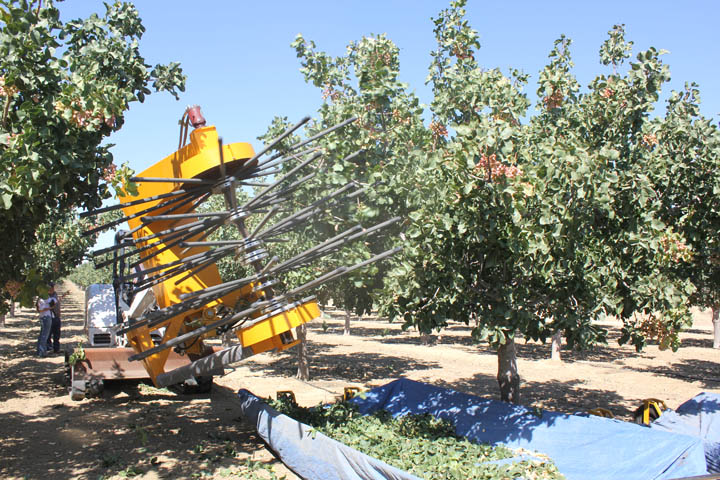
Pistachio growers might get some relief from Alternaria late blight pressure in their orchards, at least this year. That is, if drought conditions and limited available of water for irrigation continue. But, looking beyond that, the prospect is for even more pressure from this fungal disease in the future.
Alternaria, which can cause nut staining, early defoliation and, in some cases, moldy nuts, heads the list of disease concerns for California’s pistachio growers.
Growers whose orchards are in areas with a history of the disease or have areas of low, poorly draining soils are approaching the time when fungicide applications can help minimize the threat of Alternaria. The best time to attack this disease is from May through July, reports Themis Michailides, University of California plant pathologist at the Kearney Agricultural Research and Extension Center, Parlier, Calif.
Because the disease develops later in the season, bloom sprays are ineffective, he says. Treating orchards after symptoms appear does no good, either.
Continued dry weather this season would reduce development of two key factors that favor growth of Alternaria – high relative humidity levels and dew formation in orchards. Meanwhile, though, the increase in recent years in acreage of pistachios as well as almonds, another host crop, only adds to the challenge of managing this tough-to-control disease in the long term, Michailides notes.
More acres of these crops means more opportunities for the disease to develop and spread, he explains. And, in the case of pistachios, without extra equipment to harvest the added acreage, more nuts are likely to be harvested later when they are more vulnerable to Alternaria damage.
Although leaves can become infected by Alternaria earlier in the season, the critical time for development of the disease is from early August to mid-September when humid conditions prevail in the orchard, Michailides reports. Infected leaves are characterized by dark brown spots or lesions, with blackened centers, which contain the disease-causing spores. Rubbing these lesions with a finger leaves a tell-tale black color on the finger.
That’s unlike lesions caused by Botryosphaeria dothidea. Because these fungi produce no spores on the surface of the lesions, rubbing them doesn’t blacken fingers.
Late in the season both fungi can be present in the same lesion. In that case, microscopic analysis is needed to distinguish the two diseases. Michailides notes,
Wind disperses the Alternaria spores onto leaves, which cause secondary lesions, spreading the disease
Alternaria damage
Damage by Alternaria includes premature defoliation, if severe enough. This can cause problems when shaking the trees at harvest. Also, the fungus can invade the inner surface of the shell, turning the nuts moldy. However, the main threat to growers from this disease is damage to the hulls. This stains the pistachio shells, thus reducing the market value of the nuts.
“Some growers report significant loss in returns due to this damage,” Michailides says.
The later the harvest, the greater the chance of staining.
“Typically when the harvest starts in mid- to late-September, the nuts in infected orchards are very clean and show no staining,” he says. “However, as the season progresses, Alternaria moves from the leaves of the trees to the nuts.”
Although researchers have found some pistachio varieties withstand pressure from Alternaria better than others, none of the varieties have shown any significant resistance to the disease, Michailides says.
Controlling Alternaria blight requires a combination of management practices. He recommends treating orchards susceptible to the disease three or four times from May through July or about every three weeks during that period.
“The key to controlling Alternaria is managing resistance to the fungicides,” he says. “You can use the same fungicide twice in a season, if you spray a different class of fungicide in between.”
A list of fungicides that are effective against the disease and information on managing resistance of the disease to these chemicals is available online at the University of California IPM website — www.ipm.ucdavis.edu.
He offers these tips for reducing the threat of Alternaria by minimizing humidity levels in orchards.
• Eliminate areas of standing water: Keep the orchard floor dry by treating soils with gypsum, if necessary, to improve drainage.
• Avoid early-August irrigation: If disease pressure is heavy, avoid irrigating orchards for the first 10 days of August. While not a popular practice, subsurface irrigation can reduce this disease significantly, Michailides adds.
• Plant trees in north-south rows: Because winds in the San Joaquin Valley generally come from the northwest, orienting the rows in a north-south direction can improve ventilation within the orchard once the trees develop fuller canopies.
• Hedge the trees: Opening up the tree canopies, also will increase ventilation and reduce humidity levels in the orchard.
• More tips: Two more points to keep in mind: Orchards with cover crops have more Alternaria blight than disked orchards, Michailides adds. And, sunburned fruit is more susceptible to the disease than no-sunburned fruit.
About the Author(s)
You May Also Like




